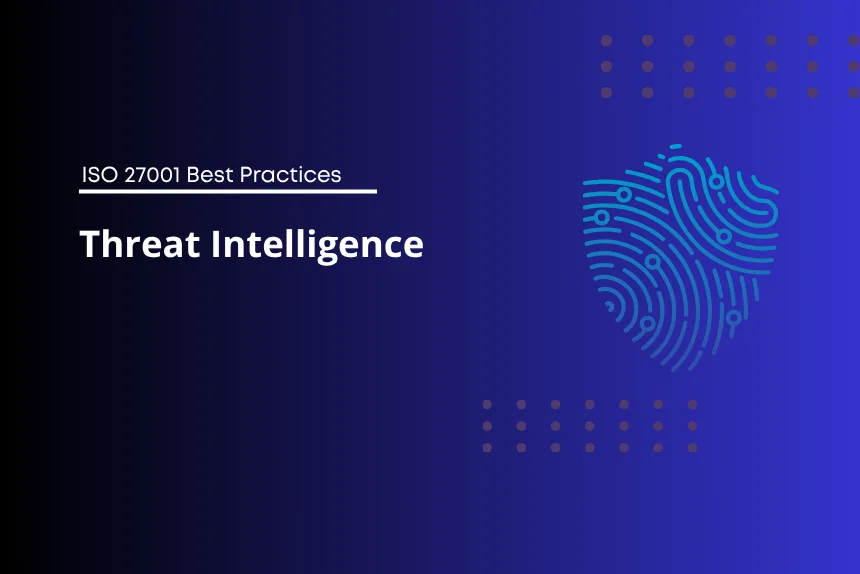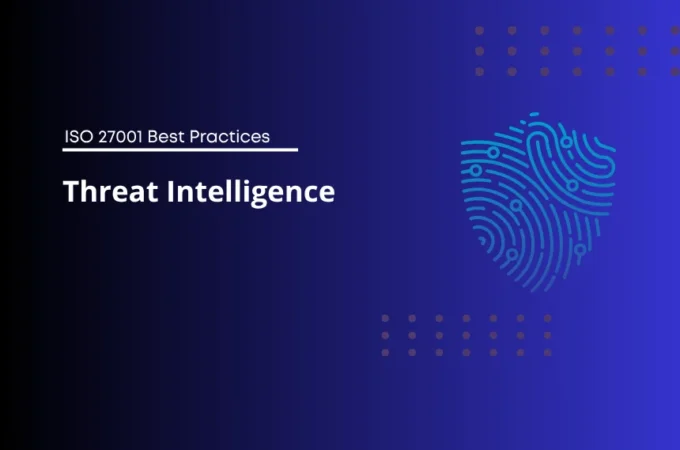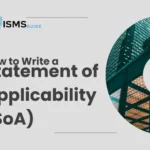Explore key Threat Intelligence concepts in an ISMS, including threat data sources, analysis methods, integration with ISO 27001, and risk-driven practices.
Table Of Content
- Threat Intelligence in ISMS
- What Is Threat Intelligence?
- Types of Threat Intelligence
- Why Threat Intelligence is Important for an ISMS
- Threat Intelligence and ISO 27001:2022
- A.5.7 – Threat Intelligence
- A.5.8 – Information Security in Project Management
- A.5.24 – Web Filtering
- A.5.28 – Secure Coding
- A.8.16 – Monitoring Activities
- A.8.28 – Secure Disposal
- A.5.30 – Outsourced Development
- Main Parts of a Threat Intelligence Program
- 1. Data Collection
- 2. Threat Enrichment
- 3. Analysis and Prioritization
- 4. Dissemination and Reporting
- 5. Automation and Orchestration
- Threat Intelligence Sources and Tools
- Open-Source Intelligence (OSINT)
- Commercial Threat Intelligence Platforms
- Security Tools Integrations
- How to Integrate Threat Intelligence into an ISMS
- Risk Assessment
- Vulnerability Management
- Incident Response
- Monitoring and Detection
- Supplier and Third-Party Risk
- Policy and Procedure Enhancement
- Threat Intelligence Best Practices
- Start with Use Cases
- Apply MITRE ATT&CK Framework
- Integrate with Risk Management
- Automate Routine Processes
- Validate Data Quality
- Use Multiple Intelligence Sources
- Conduct Continuous Improvement
- Close the Feedback Loop
- Common Problems with Threat Intelligence
- Too Much Data
- False Positives
- Lack of Skilled Analysts
- Integration Difficulties
- Limited Context
- How to Measure the Effectiveness of Threat Intelligence
- Performance Metrics
- Quality Metrics
- Maturity Stages
- Final Thoughts
Threat Intelligence in ISMS
Organizations need to move from reactive defenses to proactive security strategies as cyber threats get bigger, more complex, and more common. This change puts Threat Intelligence in ISMS at the heart of a well-established cybersecurity program. Threat intelligence helps businesses prepare for attacks, learn how their enemies act, and make smart security choices that are in line with risk management.
This complete guide goes over what threat intelligence is, how it fits into an Information Security Management System (ISMS), how it relates to ISO 27001:2022 controls, and what organizations should do to build a program that will last.
What Is Threat Intelligence?
Threat intelligence is the act of gathering, studying, and using information about possible or real threats that could harm a business. It turns raw threat data into useful information.
Threat intelligence gives answers to important operational questions:
- Who are the potential attackers?
- What techniques and tools do they use?
- What vulnerabilities might be exploited?
- How can an organization mitigate, detect, or block these threats?
Threat intelligence gives you context, which helps you make better decisions throughout the ISMS lifecycle.

Types of Threat Intelligence
There are four different layers of threat intelligence. Each one has a different job in an ISMS.
Strategic Threat Intelligence
High-level information is important for executives and planning for the long term.
Includes: trends in the industry, risks to national security, effects on regulations, and reasons why attackers do what they do.
Tactical Threat Intelligence
Describes attacker techniques, procedures, and behavior patterns.
Often mapped to frameworks like MITRE ATT&CK.
Operational Threat Intelligence
Gives detailed warnings about specific attacks or campaigns that are aimed at a certain organization or industry sector.
Technical Threat Intelligence
Highly granular indicators of compromise (IOCs), such as:
- Malicious IP addresses
- Malware hashes
- Phishing domains
- Command-and-control servers
For ISMS to work well, all four parts of threat intelligence must be combined based on how mature the organization is.
Why Threat Intelligence is Important for an ISMS
Adding threat intelligence to an ISMS makes security stronger in a number of ways:
Improved Situational Awareness
Organizations can see current and future threats that are aimed at their industry.
Proactive Risk Reduction
Threat intelligence helps find attack vectors before they are used, which makes preventive controls better.
Better Incident Response
Security teams can detect patterns, correlate events, and respond faster.
Better Vulnerability Prioritization
Threat intelligence tells you which vulnerabilities are being used, which helps you make better decisions about when to patch.
Better Compliance With ISO 27001
Some ISO 27001 controls say that you need to keep an eye on security threats and look at information from outside sources.
Organizations make sure that their security decisions are based on risk and intelligence by putting Threat Intelligence into ISMS.
Threat Intelligence and ISO 27001:2022
ISO 27001:2022 emphasizes the need for situational awareness and continuous monitoring. Threat intelligence aligns directly with several Annex A controls:
A.5.7 – Threat Intelligence
Organizations must gather, analyze, and use information on security threats.
A.5.8 – Information Security in Project Management
Threat intelligence helps identify risks in new systems or digital initiatives.
A.5.24 – Web Filtering
Threat intelligence enhances malicious domain blocking.
A.5.28 – Secure Coding
Developer teams use threat insights to avoid code weaknesses exploited by attackers.
A.8.16 – Monitoring Activities
Threat intelligence feeds enrich SIEM logs and detection capabilities.
A.8.28 – Secure Disposal
Understanding attacks on improperly disposed data strengthens disposal controls.
A.5.30 – Outsourced Development
Helps evaluate supplier risk and third-party cyber exposure.
Putting Threat Intelligence in ISMS on these controls makes the audit process work better and makes security more mature.
Main Parts of a Threat Intelligence Program
A good threat intelligence program has a lot of parts that work together.
1. Data Collection
Sources include:
- Open-source intelligence (OSINT)
- Dark web monitoring
- Industry ISACs
- Threat intelligence feeds
- Commercial CTI platforms
- Internal logs and SIEM data
2. Threat Enrichment
Without context, raw data is useless. Enrichment gives meaning by:
- Correlation
- Attribution
- Severity analysis
- TTP mapping
3. Analysis and Prioritization
Analysts use threat models and risk frameworks to figure out how useful the information they have gathered is.
4. Dissemination and Reporting
Intelligence must reach the right audience:
- Executives: strategic reports
- SOC teams: technical alerts
- Risk teams: vulnerability insights
- Developers: secure coding guidance
5. Automation and Orchestration
Automation speeds up detection, enrichment, and response workflows and reduces human error.
Threat Intelligence Sources and Tools
A variety of tools and data feeds support Threat Intelligence in ISMS.
Open-Source Intelligence (OSINT)
- AlienVault OTX
- AbuseIPDB
- VirusTotal
- Shodan
- MISP
Commercial Threat Intelligence Platforms
- Recorded Future
- CrowdStrike Falcon X
- Palo Alto Unit 42
- Check Point ThreatCloud
Security Tools Integrations
Threat intelligence feeds enrich:
- SIEM (Splunk, QRadar, Sentinel)
- EDR/XDR platforms
- Firewalls
- Email gateways
Selecting tools should depend on organizational size, industry, and compliance requirements.
How to Integrate Threat Intelligence into an ISMS
Effective Threat Intelligence in ISMS requires a structured integration into security processes.
Risk Assessment
Threat intelligence provides external context to risk analysis, improving accuracy.
Vulnerability Management
Intelligence reveals which vulnerabilities are actively exploited, enabling risk-driven patching.
Incident Response
Threat intelligence supports:
- IOC correlation
- Attack pattern detection
- Faster triage
- Root cause analysis
Monitoring and Detection
Feeds enhance SIEM rules, SOC alerts, and behavioral analytics.
Supplier and Third-Party Risk
Threat intelligence checks for:
- Supplier breach history
- Exposure in dark web sources
- Compromised credentials
Policy and Procedure Enhancement
Policies related to security monitoring, logging, acceptable use, and risk assessment benefit from threat intelligence insights.
Threat Intelligence Best Practices
To set up a good threat intelligence program, businesses should follow these tried-and-true steps:
Start with Use Cases
Define clear objectives, such as:
- Getting better at spotting phishing
- Making cloud workloads safe
- Lowering the number of false positives in SIEM
Apply MITRE ATT&CK Framework
Use ATT&CK to map adversary techniques and strengthen detection engineering.
Integrate with Risk Management
Threat intelligence should drive decisions, not operate in isolation.
Automate Routine Processes
Automation helps analyze large volumes of data efficiently.
Validate Data Quality
Remove noise, duplicates, and irrelevant indicators.
Use Multiple Intelligence Sources
Relying on a single feed creates blind spots.
Conduct Continuous Improvement
Review and update intelligence workflows regularly.
Close the Feedback Loop
What you learn from incidents should affect how you collect and use intelligence in the future.
Common Problems with Threat Intelligence
Organizations face several challenges when building threat intelligence capabilities.
Too Much Data
A lot of data makes things more complicated.
Solution: Put sources in order of importance and automate enrichment.
False Positives
SOC teams are overwhelmed with noise from low-quality IOCs.
Solution: Use threat scoring and correlation.
Lack of Skilled Analysts
Threat intelligence expertise is rare.
Solution: Training, automation, and vendor partnerships.
Integration Difficulties
Tools may not integrate smoothly.
Solution: Choose platforms with open APIs.
Limited Context
Raw data without interpretation is not intelligence.
Solution: Enrichment and contextual analysis.
How to Measure the Effectiveness of Threat Intelligence
Companies need to use useful metrics to figure out how mature Threat Intelligence is in ISMS.
Performance Metrics
- Number of actionable alerts
- Time saved through automation
- Reduction in incident response time
- Improved detection rates
Quality Metrics
- Relevance of threat insights
- Accuracy of IOCs
- Analyst feedback
- Audit results
Maturity Stages
- Initial – Ad-hoc threat data usage
- Managed – Defined collection processes
- Integrated – Connected to SOC/SIEM tools
- Optimized – Automated, adaptive intelligence
- Proactive – Predictive and strategic intelligence
Organizations should strive for a level of maturity where threat intelligence guides all significant security decisions.
Final Thoughts
Threat intelligence plays a crucial role in modern cybersecurity. Organizations can better prepare for attacks, improve their ability to find and respond to them, and stay in line with ISO 27001:2022 by putting Threat Intelligence into their ISMS. To be successful, a program needs structured processes, good data sources, automation, and a commitment to ongoing improvement.
As security threats grow more advanced, organizations that invest in intelligence-driven security will be better equipped to protect their assets, employees, and customers from evolving cyber risks.





